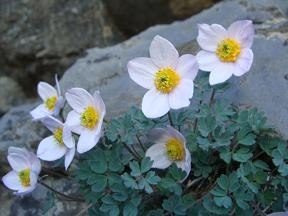
Paraquilegia microphylla
Paraquilegia microphylla, also known as the dwarf Himalayan columbine, is a rare and delicate alpine herb that thrives in the high-altitude zones of the Great Himalayan National Park (GHNP). With its finely dissected leaves and soft purple-blue flowers, it adds subtle charm to the rugged Himalayan landscape.
Habitat and Distribution
This species is typically found on rocky alpine slopes, scree beds, and among glacial moraines at elevations between 3,300 to 4,500 meters. In GHNP, it occurs in remote areas such as the upper Tirthan and Sainj valleys, where few other flowering plants can survive. It blooms between May and July, shortly after the snow recedes.
| Botanical name | Paraquilegia microphylla |
| Family | Ranunculaceae |
| Description and uses | It is a densely tufted, cushion forming, and perennial, stemless herbs. Rootstock stout covered by rigid and old leaf remains. Leaves all basal, long petioled, 2-4pinnate; leaflets deeply 2-3-lobed. Sepals purplish to purplish red, rarely white, ovate to elliptic-ovate. The best season for flowering and fruiting is June-July and rare in glacial meadows Tirthan valley. It is commonly found at an altitudinal range of 3200-4200m. |
Botanical Description
A member of the Ranunculaceae family, Paraquilegia microphylla is a diminutive perennial growing just 5–15 cm tall. Its fern-like foliage and compact growth make it well-suited to the windy, exposed alpine environment. The flowers are typically light blue to lavender and are pollinated by high-altitude insects like solitary bees.
Ecological Importance
Although it occupies a small ecological niche, this plant is part of a fragile alpine ecosystem and contributes to soil stabilization, pollinator support, and biodiversity in GHNP’s meadows. Its presence indicates a relatively undisturbed alpine habitat.
Conservation Concerns
Paraquilegia microphylla is considered vulnerable due to habitat sensitivity, climate change, and increasing human pressures in alpine zones. GHNP offers it protection, but continued monitoring and habitat preservation are vital for its survival.



